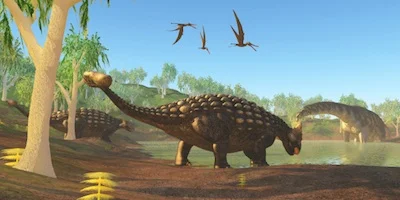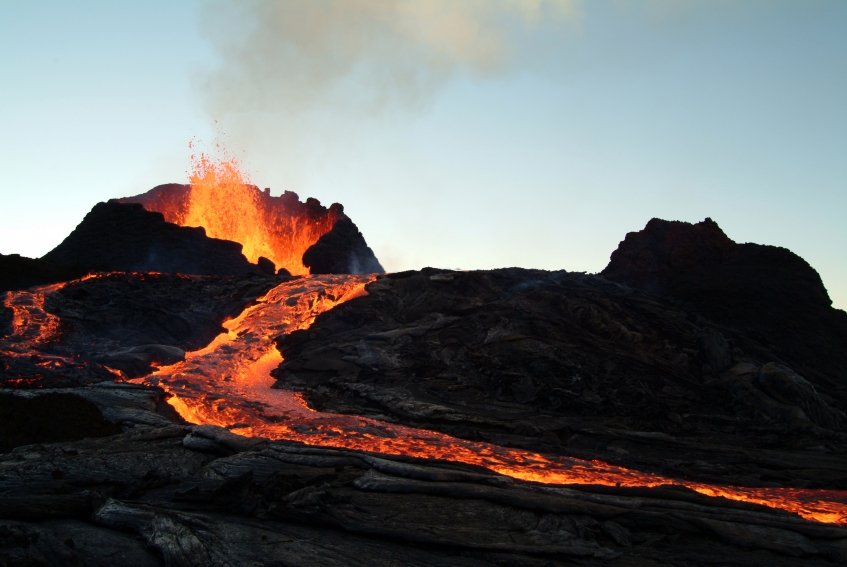Millions of years ago there were no people.
All the lands of Earth were joined together.
Then the land began to break up into smaller pieces.
Forests began to grow.
Dinosaurs, flying reptiles and swimming reptiles lived in that time
One supercontinent, Pangaea
Several hundred million years ago, all the land of Earth was one huge mass, a supercontinent, now called Pangaea (say pan-jee-uh) , which means 'all lands'.
About 230 million years ago, dinosaurs and prehistoric reptiles began to live on Earth. Dinosaurs dominated the Earth for 185 million years, long before there were any humans.
This huge chunk of time is the Mesozoic era, often called the Age of the Dinosaurs, and is divided into three smaller periods of time: the Triassic, Jurassic and Cretaceous periods.
Triassic Period
At the beginning of the Triassic (say try-ass-ik) period, there was the largest extinction of animal species ever known. About 95% of all species became extinct. The cause is not known, perhaps through massive volcanic eruptions and poisonous gases from them, but the animals that were left began to spread out over the land.
During the Triassic there was the appearance of many new forms of life. There were no dinosaurs at the start of the Triassic period, but there were many amphibians and some reptiles. In the seas, corals appeared and ammonites reappeared. On land, the plants were mainly seed plants and conifers.
Gondwana and Laurasia
In the middle of the Triassic period Pangaea started to break apart into two supercontinents: Gondwana in the south and Laurasia in the north. Mountains formed, and parts of the continents that had been inland were now on the coast, and this changed the climate in many areas.
In the late Triassic, the first mammals appeared. They were tiny, about the size of mice, and probably nocturnal (active at night).
The first turtles appeared, as well as frogs, salamanders, lizards and snakes.
The first dinosaurs were small, and most were quite similar to each other.
Pterosaurs, or flying reptiles, appeared during the late Triassic. Insects began to undergo metamorphosis to turn into adults. Marine reptiles appeared.
Cycads are still on Earth today ©Getty Images
In the plant world, cycads became plentiful. Much of the climate in the Triassic period was hot and dry, causing desert-like conditions. There were seasonal heavy rains however, forming rivers and lakes during the wet season. The polar regions were moist and mild.
The end of the Triassic period is also marked by a mass extinction. Pangaea was beginning to break apart, there were huge volcanic eruptions and about 35% of animal species died out. Most of the early dinosaurs became extinct, but some were able to adapt and evolved further during the Jurassic period.
To evolve means to change very very gradually into something that better suits a habitat or way of life. In the case of animals for example, survival of a species depends on its ability to change in a changing habitat.
Jurassic Period
The Jurassic (say joo-rass-ik) is the middle period of the Age of Dinosaurs. The breaking up of Pangaea that had started in the Triassic was completed in the Jurassic : the splitting of the the massive supercontinent into two smaller supercontinents: Laurasia in the north and Gondwana in the south. Scientists call this movement 'continental drift'.
If the continents were a jigsaw puzzle, you could see how they had once fitted together as one supercontinent
The continental drift continued as gradually Gondwana and Laurasia broke into the continents we know today. Laurasia broke into the landmasses we know as Europe, Asia and North America. Gondwana broke into the landmasses now known as Africa, South America, India, Madagascar, Australia, New Zealand and Antarctica. Australia and Antarctica remained joined together until 45 million years ago when Australia drifted northwards and the ice cap began to form on Antarctica.
Lava flowing from an erupting volcano. Image©Jupiter
There were huge volcanoes with rivers of lava and clouds of poison gases. Land that had been part of the interior of the huge continent was now coastline of smaller continents, and the climate began to change accordingly. The arid deserts of the Triassic were transformed into thick rainforests.
The dinosaurs now dominated the land, bigger reptiles swam in the oceans or flew in the skies.
Forests of ferns, gingko trees, cycads and conifers grew. All these plants can still be seen today. Scuttling about at the bottom of these plants were the early mammals, all of them rat-sized. The dominant land animals were the huge dinosaurs, the largest land animals ever to walk the earth. They were the gigantic herbivore (plant eating) sauropods such as diplodocus and brachiosaurus, and the carnivourous (meat eating) dinosaurs such as allosaurus and dilophosaurus.
The Evolution Garden in Singapore shows what forests might have been like in the Jurassic ©Getty Images
The dinosaurs of the Jurassic were much more different from each other than in other periods: there was a greater variety. Because the different climates caused forests to grow, the herbivores became huge in order to feed on the tall trees. The carnivores then had to become larger and more fierce to hunt such huge prey.
The first birds appeared during this era, such as archaeopteryx. The seas were full of marine reptiles such as the plesiosaurs, crocodiles, ichthyosaurs, sharks and rays.
Cretaceous Period
Some things happened in the Cretaceous (say cret-ay-shus) period that were important to life on earth. One of these was the development of flowering plants. By the end of the period, there were many that we would recognise today, such as magnolias and waterlilies.
Magnolia flower ©Getty Images
The number of different insects increased during this period too. The bees helped the spread of the flowers. The beginnings of many modern insects were at this time: ants, grasshoppers, butterflies, aphids and termites among them.
The Great Extinction at the end of the Cretaceous Period
At the end of the Cretaceous period there was another great extinction of many species, including dinosaurs.
Birds, small reptiles and mammals, many marine creatures and plants survived.
Dinosaurs did not survive the end of the Cretaceous period ©Getty Images
Scientists believe a giant meteor hit the earth, causing massive destruction, tidal waves, acid rain, and huge clouds of dust that blocked the sun's rays from reaching the Earth to light and warm it.
The dinosaurs were among the many species that were wiped out. Following the great extinctions, there was a slow recovery and evolution of new species. Evolution is the gradual changes animals and plants make to adapt to a changing environment in order to survive.
To evolve means to change very very gradually into something that better suits a habitat or way of life. In the case of animals for example, survival of a species depends on its ability to change in a changing habitat.
It’s a good idea to get information from more than one source!
Watch a video that tries to explain what killed the dinosaurs
Look at diagrams showing the stages of continental drift in each of the periods of the Age of the Dinosaurs:
http://earthguide.ucsd.edu/eoc/teachers/t_tectonics/p_pangaea2.html
Watch an animation of continental drift: the supercontinent gradually breaking up to become the Earth as we know it today:
http://www.tectonics.caltech.edu/outreach/animations/drift2.html
Read more about the Mesozoic era:
http://www.dinodatabase.com/dinoage.asp
Read the kidcyber pages:
Some dinosaurs of the Triassic period
Some dinosaurs of the Jurassic period
dinosaurs of the Cretaceous period
Dinosaur Discoveries - Fossils









